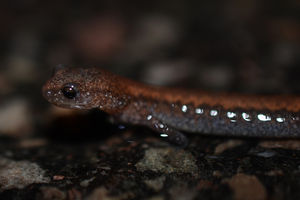Eastern red-backed salamander
Physical Description
Plethodontidae is the family that the eastern red-backed salamanders are classified in, as they are lungless. Oxygen dissolves into the moisture on their skin and then the oxygen is absorbed into the skin. It is vital for them to maintain their moisture, without it they cannot breathe. It should also be noted that one should not physically handle a salamander for long period of time as they can lose that moisture. These salamanders come in two different color phases, the first being the lead-back, and the other being the red-back. The red-backed phase is the usual coloring of reddish orange along the back. Lead-backs have a dark grey to black coloring over their body. Adults will reach about 2-5 inches in length.

Geographic Distribution & Habitat
Eastern red-backed salamanders can be found as far south as North Carolina, west over to Ohio, and north into New England through Nova Scotia. They can be found in varying types of forests, from deciduous or coniferous. Dry or sandy soils will usually be avoided by this species. Like most salamanders one can find them hidden under logs, leaf litter, and rocks as they are most active during the night.

Ecology
Their role in the ecosystem of soil is vitally important, especially in regards to the fungal community. Many invertebrates feed upon fungus as a source of nutrition. The salamanders ensure a balance is kept by controlling the populations of these insects [2].
Reproduction
Mating season for eastern red-backs begins in sometime between October through December. Males will follow the pheromone trails left by the females. The courtship initiates with the male rubbing his head on the female's snout. After the rubbing has ceased the male then deposits the spermatophore and the female retrieves it. A very large amount of energy is required for the females to produce their eggs, so it is thought that they only breed once every other year. She lays her eggs sometime in the summer. Most amphibians will leave their eggs after they have been laid but these salamanders remain with them until hatching occurs [2]. Eggs then hatch two months later in August or September.
References
[1] Harding, J. & Mifsud, D. "Amphibians & Reptiles of the Great Lakes Region". University of Michigan Press, 2017. pg 99-102
[2] Clark,E. "Essential ubiquity: "How one tiny salamander species has a huge impact" Mongabay Series: Salamanders, 21 December 2018
[3] AmphibiaWeb. 2021. <https://amphibiaweb.org> University of California, Berkeley, CA, USA.
[4] Eastern red-backed salamander photographed by Larry Clarfeld on April 26th, 2018 from iNaturalist